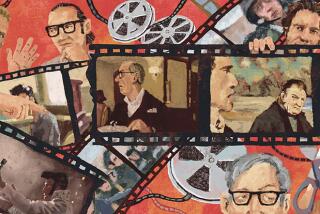You’ve Got to Pick and ‘Oliver’--or Two
- Share via
The movies have always had a love affair with the Charles Dickens novel “Oliver Twist.”
Silent film companies had a field day with it. The first version was made in 1909, and the most famous silent version was made in 1922 with Lon Chaney as Fagin and Jackie Coogan as Oliver. It’s available on Republic Home Video.
In 1933, a mediocre low-budget version was made with Irving Pichel as Fagin and Dickie Moore as Oliver (you may remember him from “Our Gang” comedies). That film is now in the public domain and available from a variety of companies, including Congress Video.
Director David Lean’s brilliant adaptation of the book was released in 1948 with Alec Guinness as a definitive Fagin, John Howard Davies as Oliver, Anthony Newley as the Artful Dodger and Robert Newton as a devilish Bill Sikes. It’s a remarkable realization of 19th-Century London with Guy Green’s extraordinary black-and-white photography, John Bryan’s letter-perfect design and composer Arnold Bax’s superlative music. The 116-minute black-and-white classic is available on Paramount tape and a razor-sharp black-and-white laser videodisc.
There was no challenge to the Lean version until 1982, when George C. Scott’s Fagin and James Goldman’s literate script turned a routine TV movie into a first-rate production. That version is not available on videotape. An animated version, also produced in 1982, is available on Vestron tapes.
A BBC television production made in 1985 covers every nuance of the Dickens classic in a massive 333-minute extravaganza now available on two CBS/Fox tapes. It features a cast of superlative British actors and is authentic, complete and recommended.
But if you want to experience the spirit of the book, as well as one of the most joyous musical experiences ever put on film, there is nothing like “Oliver!”-Sir Carol Reed’s tour-de-force 1968 musical version (145 minutes, RCA-Columbia Pictures tape and laser videodisc). This superb film won six Academy Awards, including best film and best director.
Unfortunately, the musical has not yet been released in a letter-box version, and the wide-screen action cannot be adequately crammed into the square TV screen. The home viewer ends up seeing only bits and pieces of the film. Because of this, Sir Carol Reed’s full-screen direction (something is usually happening in every part of the wide screen), John Box and Terence Marsh’s art direction and especially Onna White’s award-winning choreography suffer greatly.
Still, the delightful performances are largely intact-Ron Moody’s performance as Fagin is the most sympathetic portrayal ever put on the screen, sweet-faced Mark Lester’s Oliver, an irresistible Jack Wild as the always moving Artful Dodger, a terrifying Oliver Reed as a vicious Bill Sikes, a vulnerable Shani Wallis as Nancy.
Lionel Bart’s expert musical score features one show-stopping number after another that perfectly capture the spirit of Dickens. The music sounds terrific on any home stereo system.
Encore scenes: the memorable, continuous opening sequence that takes Oliver from the workhouse to indentured servitude (it includes Lester’s perfect reading of “Please, sir, I want some more” and an unforgettable performance by Harry Secombe as Mr. Bumble); the Artful Dodger showing Oliver Dickens’ London in the lavish production number, “Consider Yourself”; Fagin teaching Oliver how to “Pick a Pocket or Two” (with the faces of Fagin’s boys burned into the memory); Nancy, Oliver and the boys in “I’ll Do Anything”; Fagin cautioning his charges to “Be Back Soon”; the joyous, massive production number, “Who Will Buy?”; Nancy’s moving torch song, “As Long as He Needs Me”; Fagin’s crafty “Reviewing the Situation,” and the climactic scene in which Sikes is killed, Fagin and the Artful Dodger head off for a profitable future and Oliver gets his just rewards.
More to Read
Only good movies
Get the Indie Focus newsletter, Mark Olsen's weekly guide to the world of cinema.
You may occasionally receive promotional content from the Los Angeles Times.






